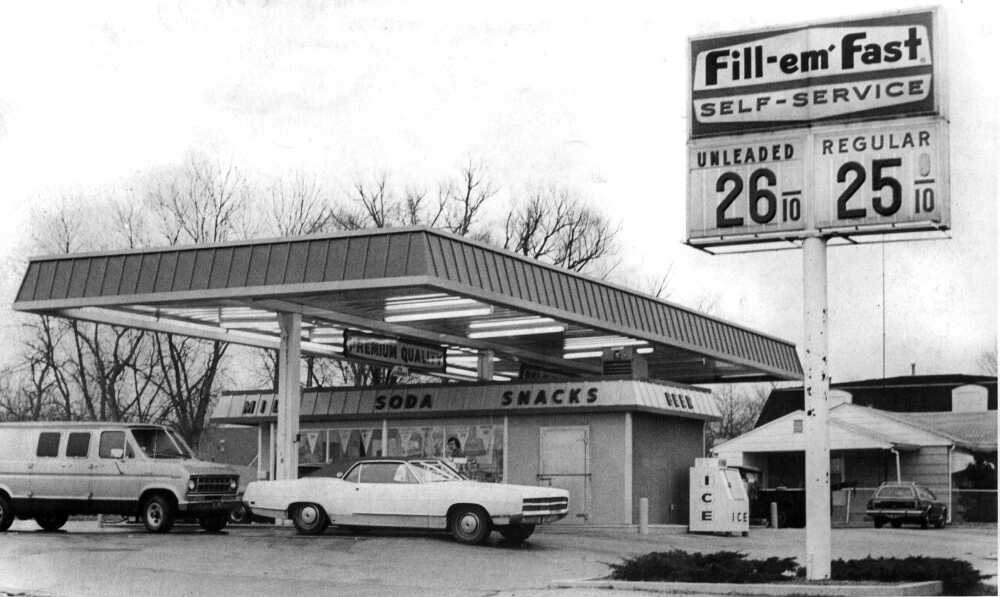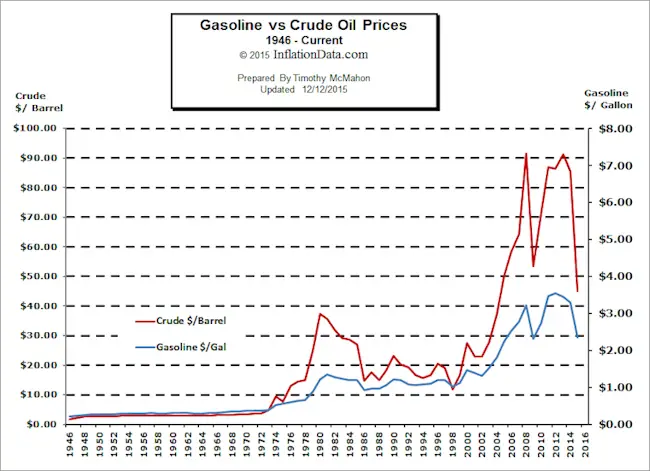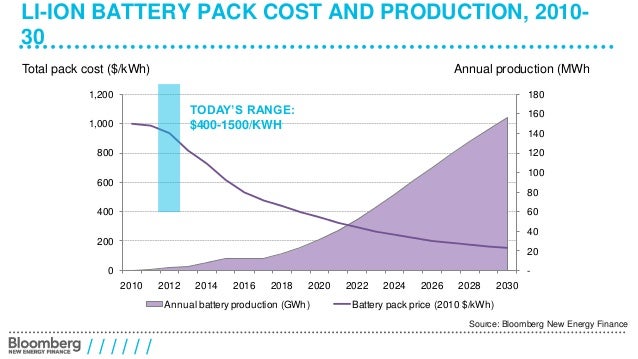
I can remember my mom pulling into the gas station and buying gas. The price was 25 cents per gallon. When I started college, I worked at Donner Gate Chevron gas station next to Donner Lake and Lake Tahoe in the Sierra Nevada mountains. The price then was 50 cents per gallon. One year later when I returned to work at the station a second year, after the Arab oil embargo, the price had jumped from 50 cents per gallon to $1.00 per gallon. Oil producers profits no doubt doubled overnight due to the manufactured shortage.

A while ago, the price had reached over $4.00 per gallon after a steady and relentless series of price hikes over a period of a few years and then, overnight, the price dropped to as low as $2.20. Why?
What would you do if you had an asset (oil) and you wanted to maximize your income from that asset? You own a lot more than can be sold in a year and in fact, you own many decades worth of the asset.
To increase income you can increase the number of barrels you sell per year at a fixed price, or, you can increase the price per barrel at a fixed volume. The former will consume your reserves more rapidly, whereas the latter will preserve them. So of course you will desire to increase the price per barrel of oil and that means, increasing the charges per gallon of gasoline at the pumps.
This is what we saw up to about a year ago when the price had reached as much as $5 per gallon at some stations.

Then, all of a sudden the price dropped. I can now find gas stations selling gasoline for $2.20 per gallon . It seems like a short time ago I paid $4. Certainly the cost of getting oil out of the ground didn’t get cut in half in 2 years. What happened? I don’t want to complain, but having lived a life where the cost of gasoline has steadily increased, this is unusual so there must be something that motivated it. But what?
I think what happened is that Oil Giants began to believe in Electric Vehicles. Sales of the Tesla Model S were growing steadily and rumors of the Model 3 had likely been heard.

In 2015 Tesla announced the Model 3 and in 2016 received ~500,000 pre-order deposits for the ~$35,000 consumer car.

This car will have a range of over 200 miles, similar to it’s Model S and Model X cousins. Both of these cars, while pushing the boundaries of technology, work. They are real items available for purchase, that actually move down the roadways carrying their owners to and from work and play.
All of those pre orders sparked Chevrolet to step up it’s EV program and announce that it would release the Chevy Bolt in late 2016 as a 2017 model. The Chevy Bolt will also have a 200+ mile range and be the only competitor to the Tesla Model 3. In fact, the Chevy Bolt is according to their web site, available now with the Model 3 coming out within about a year.
How well the Chevy Bolt fairs in the market place remains to be seen after their fiasco with the EV1 and the ensuing revolt documented in Who Killed the Electric Car?
At the same time, virtually every other car maker flipped their EV development programs into high gear. The Tesla pre orders took everyone by surprise, including Tesla. What it showed, is that people have not been purchasing EV’s because the range has been too small.
I for one have not been interested in an EV for exactly that reason. If I need to drive to Sacramento (50 miles) for business or shopping, drive around 30 to 50 miles running errands and then come back home, the round trip distance is easily 160 miles. With a 50 mile range EV, I can’t make the trip. With a 200 mile range, I can. This is simple. Even the Nissan Leaf with ~100 mile range is worthless to me as I’m not going to hunt around a parking lot for an electrical outlet to plug in so I can get back home.
The number of times I need to travel close to 200 miles in a year are small, maybe 10 or so. But they are not 0. And I want my car to work for every trip I need to make. I could deal with charging on a trip to San Francisco airport for a vacation, but not to Sacramento, a day trip.
OK, fine. People want an EV to have more than 200 mile range. But what does this have to do with oil?
For the first time we have 2 viable solutions (Model 3 and Bolt) to transportation that get their “fuel” from an electrical outlet instead of a gasoline pump. This means I can now install a 2 or 3 kW solar power system to fuel my car forever, and never have to go to buy gasoline again.
Wow.
When the cost of gasoline rose to the $4.00 realm in 2015, people actually thought about whether they needed to drive to some destinations, reducing their consumption. People were angry with the cost of gasoline, cut back on driving, and began to wonder, “Is there a better way?”

Up to $5.00 per gallon gasoline in 2015 helped fuel the 500,000 pre orders for Tesla Model 3’s a year later.
Rising Model S sales and rumors of a Model 3, I think, woke up the oil producers who one day in 2015 woke up and thought: “Oh bleep, we just helped cause the birth of an EV industry. Charging this much for oil increases revenue today, but dramatically shortens the EV adoption time scale. This is (very) bad for our long term integrated revenue.”
If EV sales come on line in earnest, hundreds of trillions of dollars of oil reserves on the books become nearly worthless. EV market penetration is the bane of the oil industry (and boon for the planet’s health)
“How can we delay the penetration of EV’s into our market space?” the oil industry wondered and no doubt, wonders. The answer is simple: “Let’s reduce the cost of gasoline so people are less motivated to purchase an EV. This way we earn fewer dollars per barrel of crude, but, we manage to sell more barrels in the coming decade and we delay our certain demise”
I think this is why the prices dropped. The oil industry woke up to the fact that EV’s are a real threat to future oil sales.
You see, they were pushing for increasing the dollars per barrel for their hundreds of trillions of dollars of assets still in the ground. But what they finally managed was to piss people off to the point that many decided enough is enough. They gave rise to a significant number of people who are now bothered by the smell of gasoline as they fill their tanks.
People purchasing solar power systems for their homes are realizing they can add 2 or 3 kW of solar power and use that to fuel their EV forever. Think of that: the owner of an EV and a solar power system will have free electricity for their home and free “gasoline” for the car, (essentially) forever.
All of a sudden, completely counter to all past experience, increasing the cost per gallon of gasoline engendered a revolt. It led to a reduction in future oil consumption and an increase in EV sales. This (Model 3 deposits) was the first time in history that a significant number of people, all at once, put their money where their good intentions were and decided to make the switch from gas to electricity.
I suspect certain oil industry experts woke up and realized that they had just given birth to a movement that would render their vast underground wealth, worthless…… or at least, worth less. This “Oh Bleep” moment was quickly countered with an overnight price drop.
Fortunately for the planet, this reaction was too little too late. A number of people woke up, opened their eyes and saw Schrodinger’s Oil Cat…… and it materialized.

The EV revolution was born and there is no going back to the previous unknown state of affairs.
Sure, we will still use oil for plastics and fertilizers. But gasoline and diesel for transportation has been the largest consumer of oil pumped out of the ground. If that industry is replaced by solar energy harvested from the sun, via EV adoption and battery storage development, then it will take a tiny down turn in consumption to cause an enormous battle amongst oil nations as they vie for declining demand.
It will become a consumers market and this shift is likely to happen in just a couple of years as new, 200+ mile range EV’s come to market. By 2020 we will probably have 20 to 30 new EV models with over 200 mile range.
For the first time since the earliest days of oil, it may well be that we are about to have more oil produced than people desire to burn. Demand reduction will drive even larger price cuts as oil producers have a lot of oil to sell, with a declining customer base to sell to.

Producers will be competing to sell their product (gasoline and diesel fuels) amidst a market glut **if / when** half the market is eliminated by electric cars fueled by solar (this assumes batteries improve).
And we all know what happens when supply is large and demand is low…..prices drop and companies (or in this case countries) go bankrupt. The countries that produce oil at the lowest cost will hold on the longest while those with higher overhead will go bust. It would be wise to invest in technologies beyond black gold, IMO.
This may turn out to be the best bad thing ever to happen to the industrialized planet. In other words, this is great news for the environment. And it’s exactly the outcome Elon Musk hoped EV adoption might produce.
Congratulations, almost, Elon. the cards are in play and the outcome looks highly likely. I’d sell that oil stock before the end game becomes obvious to the stock markets. And Oil Countries, I’d try to figure out what you’re going to sell when no one wants oil for cars and you actually need to produce something useful or go back to your pre oil status.
Happily, a reduction in oil sales will reduce funds now used for terrorism. Want to help stop terrorism, then go buy an EV and a solar power system to fuel it.
Ironically, the oil in the ground may well stay there far longer than Hubbert’s Peak projected.
Keep an eye on battery storage cost reductions and performance improvements as that will be key to accelerating this transition.

If the cost per kWhr storage is cut in half, and the storage capacity in kWhr/kg per unit weight is doubled as is anticipated by some, then EV adoption will take off in spades.

An EV car for the masses with a 400 mile range, costing less than a gasoline car and enjoying zippier acceleration, near zero maintenance, and no stops at a gas station….. would rock the industry.
Already it costs something like $6.00 worth of electricity to charge a car to the same range as $60.00 worth of gasoline. Solar energy today, fully amortized, costs about 8 cents per kWhr so a 70kWhr battery pack costs about $5.60 to charge.
Let’s see, do I prefer spending $240 per month on gasoline or $50 per month for a solar power system I purchase and own (amortized 20 yrs at 6%)?
To be fair, the cost of “fueling” an EV is misleading. The cost given by EV makers and by me here, does not include the replacement cost of the battery pack. This is the piece of the puzzle the EV manufacturers haven’t wanted to talk about in the past. The cost per mile for the battery pack was large, and ruined the claimed low cost.
However, even that negative is already eliminated. The amortized cost for a replacement battery pack is already below $100 per month and this will likely fall to below $50 by the time someone actually needs to replace their EV battery pack. At any rate, the EV’s being sold come with new battery packs, so this is an issue most buyers don’t consider.
So I give the EV a full green light. The industry is ready to go, indeed, it is going already. When I can afford it, I intend to purchase an EV and install 3kW of solar power to fuel it forever.
Sure, in 30 to 50 years one solar panel will fail this year or that, reducing my production to 90% for a few days until I get it replaced. I’ll just replace it and be back up to full production capacity within days of realizing production is down (which is all computer data logged and easy to determine). So, hang on to your seats, the world is about to change in a big way.
I took a test drive in a Model S Tesla.

It was more fun than a roller coaster ride. The first surreal experience happened just as I rounded the corner onto Sierra College Blvd, shortly after departing from the Roseville, CA Tesla dealership.
There on the corner is a larger than normal, gas station. As I was maneuvering around the corner, I gazed over to the right, saw the station and realized…………”If I owned this car, I would never again go there for gasoline.” In the past I would have noted, “There’s a station for future reference”. So this new thought took me by surprise.
Later, we meandered to a long straight stretch with no one (and no officers) to be seen ahead or behind. From a dead stop on a back country road, I floored the accelerator peddle. The wheels became light, close to breaking free. I was pushed back in my seat, my eyes were slightly blurred and as I didn’t expect that much acceleration I slightly pulled back on the accelerator.
Having street raced 750cc motorcycles in Redwood Canyon (Oakland) and driven the “Sunday Morning Ride” from San Rafael over Mt. Tamalpias (a not so legal Sunday country ride) and zipped around in sports cars most of my life, I was surprised by the torque even though as a Mechanical Engineer I knew it existed. I hadn’t expected to consider reducing how hard I pushed on that accelerator peddle.
I was sold. I desire an EV now. Both for the fun of driving it, and for the end of my days of filling up at gas stations. Having thought about it for the past several months, I will far prefer plugging in my car most evenings compared to having to pump smelly gasoline into my car. Every day when I leave the house, I’ll have a full tank of electrons. And now, each time I fill up my car, or take off in the morning and smell gasoline fumes, I’m repulsed.
What about the problem of long distance travel?
Thinking about this “problem” it seems logical to me that as soon as a lot of EV’s are moving down the roads, every restaurant, coffee shop, store, and who knows where else, will install charging stations.

Why not? A driver on a rare, long trip, will be more than happy to pay $20.00 to “fill up their batteries”. After all, we’ve been paying $50 or more to fill up a tank of gas. Given that it will only cost the restaurant $6.00 for that electricity, it’s a revenue generator that increases their main business (food) to boot. “EV Charging Station, coffee shop / restaurant, Next Exit” will be a common future billboard I’m sure.
As soon as EV’s take to the road en masse, charging stations will pop up like mushrooms on the second warm day after a long series of cold rains. Meanwhile, the 200 plus mile range will do for almost all of my driving needs and I’ll keep my gas car until the mushroom hunt is easy.
We have 2 years before the ITC ends for solar power, so get it while it’s hot.
rt